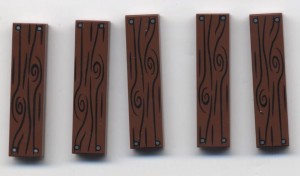Far from being an exact science, clustering potential is a term that I use to indicate a buyer’s likelihood of desiring multiple quantities of the exact same piece. A seller can try to gauge clustering potential before choosing a new LEGO piece to add to their inventory.
Clustering Potential Example 1: Luke Skywalker vs. Stormtrooper Minifig
A Luke Skywalker minifig represents a unique Star Wars character, so buyers may only require one Luke Skywalker minifig for their collections. A stormtrooper minifig, on the other hand, is a generic minifig–a nameless foot soldier of The Empire. Buyers may want anywhere from one to one hundred or more stormtrooper minifigs if the buyer is amassing an entire Minifig Empire of Stormtroopers to conquer the galaxy! Muahahaha.
It’s a much less likely scenario–but never entirely unheard of–that a buyer will want an army of a hundred Luke Skywalker minifigs. If you’re selling your Luke Skywalker minifigs for dirt cheap, say $1 each, then someone may buy 100 Luke Skywalker minifigs from you in one transaction. Assuming that you’re pricing the minifigs at the average market price or higher, then generic, nameless minifigs like stromtroopers, soldiers, sailors, pirates, police officers, etc. are often more likely to sell in clusters of higher quantities than unique character minifigs like Luke Skywalker, Jack Sparrow or Buzz Lightyear.
Clustering Potential Example 2: Standard LEGO Bricks vs. Tiles with a Printed Design
Standard LEGO brick, plate, tile and slope pieces generally exhibit high clustering potential because a large scale LEGO project may demand dozens or hundreds of the same brick. On the other hand, some pieces with a unique printed logo or design can have lower clustering potential. For example, the United Nations Headquarters LEGO set contains 155 trans-light blue 1×2 plates, but only one “United Nations” 1×8 printed tile. If a buyer is building the United Nations Headquarters, they probably only want one “United Nations” tile. Again, if you’re pricing your “United Nations” tiles below market value, one buyer–possibly a reseller–could purchase all of your tiles.

LEGO tiles with wood grain pattern have high clustering potential since buyers may build a floor with dozens or hundreds of the same tile.
Printed tiles are not always “bad” for clustering, though. In fact, some printed tiles, like the lovely reddish brown tile with wood grain pattern, have high clustering potential since your buyer may be constructing an expansive wood grain floor as part of an MOC*.
* * *
Clustering potential–along with other factors like price, quantity, demand, markup potential, piece size/weight, piece durability, etc.–can help guide your inventory selection decisions for your eBay store. How heavily should clustering potential sway your inventory purchasing behavior? That’s up to you, nevertheless clustering potential and uniqueness are at least worth noting before charging into a new inventory investment, especially if the investment includes a high volume purchase of a single piece.
* MOC is an acronym for “My Own Creation”. MOCs are personal projects designed and built by LEGO fans of all ages.

